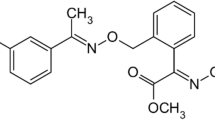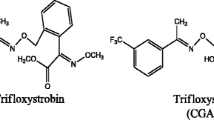Abstract
The health risk to humans of pesticide application on minor crops, such as strawberry, requires quantification. Here, the dissipation and residual levels of three fungicides (pyraclostrobin, myclobutanil, and difenoconazole) were studied for strawberry under greenhouse conditions using high-performance liquid chromatography (HPLC)-tandem mass spectrometry after Quick, Easy, Cheap, Effective, Rugged, and Safe extraction. This method was validated using blank samples, with all mean recoveries of these three fungicides exceeding 80 %. The residues of all three fungicides dissipated following first-order kinetics. The half-lives of pyraclostrobin, myclobutanil, and difenoconazole were 1.69, 3.30, and 3.65 days following one time application and 1.73, 5.78, and 6.30 days following two times applications, respectively. Fungicide residue was determined by comparing the estimated daily intake of the three fungicides against the acceptable daily intake. The results indicate that the potential health risk of the three fungicides was not significant in strawberry when following good agricultural practices (GAP) under greenhouse conditions.

Similar content being viewed by others
References
Athanasopoulos, P. E., Pappas, C. J., & Kyriakidis, N. V. (2003). Decomposition of myclobutanil and triadimefon in grapes on the vines and during refrigerated storage. Food Chemistry, 82, 367–371.
Chun, O. K., & Kang, H. G. (2003). Estimation of risks of pesticide exposure by food intake, to Koreans. Food and Chemical Toxicology, 41, 1063–1076.
FAO/WHO (1992). Pesticide residues in food and feed. (Maximum Residue Limits for Myclobutanil). http://www.codexalimentarius.net/pestres/data/pesticides/details.html?id=181.
FAO/WHO (2003). Pesticide residues in food and feed. (Maximum Residue Limits for Pyraclostrobin). http://www.codexalimentarius.net/pestres/data/pesticides/details.html?id=210.
FAO/WHO (2007). pesticide residues in food and feed. (Maximum Residue Limits for Difenoconazole). http://www.codexalimentarius.net/pestres/data/pesticides/details.html?id=224.
Liu, Y., Sun, H., Liu, F., & Wang, S. (2012). Dissipation and residue of myclobutanil in lychee. Bulletin of Environmental Contamination and Toxicology, 88, 902–905.
Moshe, R., & Dimitri, S. (2002). Effects of azoxytrobin, difenoconazole, polyoxin B (polar) and trifloxysrobin on germination and growth of Alternaria alternata and decay in red delicious apple fruit. Crop Protection, 21, 951–955.
SANCO/12495/2011 (2011). Method validation and quality control procedures for pesticide residue analysis in food and feed. http://ec.europa.eu/food/plant/protection/pesticides/docs/qualcontrol_en.pdf(last accessed April 2003).
Wang, L.D. (2005). Dietary intake of residents of the country in 2002 (Eds.), China nutrition investigation report and health status of residents in 2002 (pp. 18–24). Beijing: People’s Medical Publishing House.
Wang, K., Wu, J. X., & Zhang, H. Y. (2012). Dissipation of difenoconazole in rice, paddy soil, and paddy water under field conditions. Ecotoxicology and Environmental Safety, 86, 111–115.
You, X., Liu, C., Liu, Y., & Dong, J. (2012). Dissipation of pyraclostrobin and its metabolite BF-500-3 in maize under field conditions. Ecotoxicology and Environmental Safety, 80, 252–257.
Zhang, F., Wang, L., Zhou, L., Wu, D., Pan, H., & Pan, C. (2012). Residue dynamics of pyraclostrobin in peanut and field soil by QuEChERS and LC-MS/MS. Ecotoxicology and Environmental Safety, 78, 116–122.
Acknowledgments
This work was supported by the Special Fund for Agro-scientific Research in the Public Interest (Grant No. 201303088).
Author information
Authors and Affiliations
Corresponding author
Rights and permissions
About this article
Cite this article
Sun, C., Cang, T., Wang, Z. et al. Degradation of three fungicides following application on strawberry and a risk assessment of their toxicity under greenhouse conditions. Environ Monit Assess 187, 303 (2015). https://doi.org/10.1007/s10661-015-4539-x
Received:
Accepted:
Published:
DOI: https://doi.org/10.1007/s10661-015-4539-x




